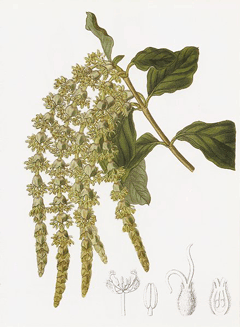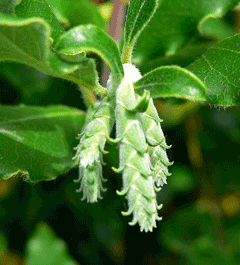 |
|
http://commons.wikimedia.org/wiki/File:Garrya_elliptica_RHS.jpeg |
 |
| http://commons.wikimedia.org/wiki/User:Stan_Shebs |
Translate this page:
Summary
Physical Characteristics

 Garrya_elliptica is an evergreen Shrub growing to 4 m (13ft) by 4 m (13ft) at a medium rate.
Garrya_elliptica is an evergreen Shrub growing to 4 m (13ft) by 4 m (13ft) at a medium rate.
See above for USDA hardiness. It is hardy to UK zone 8. It is in leaf all year, in flower from November to February. The species is dioecious (individual flowers are either male or female, but only one sex is to be found on any one plant so both male and female plants must be grown if seed is required). . The plant is not self-fertile.
Suitable for: light (sandy), medium (loamy) and heavy (clay) soils, prefers well-drained soil and can grow in nutritionally poor soil. Suitable pH: mildly acid, neutral and basic (mildly alkaline) soils. It can grow in full shade (deep woodland) semi-shade (light woodland) or no shade. It prefers dry or moist soil and can tolerate drought. The plant can tolerate maritime exposure.
It can tolerate atmospheric pollution.
UK Hardiness Map
US Hardiness Map
Synonyms
Plant Habitats
Edible Uses
References More on Edible Uses
Medicinal Uses
Plants For A Future can not take any responsibility for any adverse effects from the use of plants. Always seek advice from a professional before using a plant medicinally.
The leaves are intensely bitter and are used as an antiperiodic and febrifuge. They can be used as a quinine substitute[46, 61, 95]. An infusion has been used to induce menstruation, probably acting as an abortifacient[257].
References More on Medicinal Uses
The Bookshop: Edible Plant Books
Our Latest books on Perennial Plants For Food Forests and Permaculture Gardens in paperback or digital formats.

Edible Tropical Plants
Food Forest Plants for Hotter Conditions: 250+ Plants For Tropical Food Forests & Permaculture Gardens.
More

Edible Temperate Plants
Plants for Your Food Forest: 500 Plants for Temperate Food Forests & Permaculture Gardens.
More

More Books
PFAF have eight books available in paperback and digital formats. Browse the shop for more information.
Shop Now
Other Uses
Grows well by the sea and can be grown as a hedge in the milder parts of Britain[29, 166]. A hedge in a sheltered position at Wisley in 1991 was very healthy[K]. Makes a good wind shelter[166]. Grey to black dyes are obtained from the berries. The colour varies according to the ripeness of the fruit, green fruits are the best[168]. The bark and leaves are very bitter, a possible insect repellent?[K]. Wood - hard, close-grained. It has been used for fine cabinet work, though its small size and rarity limits its commercial usefulness[229].
Special Uses
References More on Other Uses
Cultivation details
Prefers a sunny position succeeding in most well-drained fertile soils[182, 200, 202]. Succeeds in a hot dry position. Succeeds in light shade[202], the plants are also tolerant of quite deep shade[219]. Does not require a rich soil or abundant moisture[11], if the soil is too fertile the flowering will be delayed[200]. Plants are resistant to urban pollution and maritime exposure, but they are subject to wind scorch from cold drying winds in colder areas[184]. This species is hardy to about -15°c[184], it is best on a sunny wall in most parts of the country but does very well as a free standing shrub in Devon and Cornwall[11]. In cold winters and springs the previous year's leaves may fall before the new leaves are produced[202]. A hedge in a relatively open area at Wisley in Surrey is growing well (1991), as is a plant in a friend's garden in Stockton on Teesside(1998)[K]. All pruning should be carried out in spring before new growth starts but after flowering has ended[1]. Plants are strongly resentful of root disturbance[1, 11], they should be planted into their permanent positions as soon as possible. Dioecious. Male and female plants must be grown if seed is required.
References Carbon Farming Information and Carbon Sequestration Information
Temperature Converter
Type a value in the Celsius field to convert the value to Fahrenheit:
Fahrenheit:
The PFAF Bookshop
Plants For A Future have a number of books available in paperback and digital form. Book titles include Edible Plants, Edible Perennials, Edible Trees,Edible Shrubs, Woodland Gardening, and Temperate Food Forest Plants. Our new book is Food Forest Plants For Hotter Conditions (Tropical and Sub-Tropical).
Shop Now
Plant Propagation
Seed - best sown as soon as it is ripe in a cold frame. Very slow, the seed can take 2 or more years to germinate. When they are large enough to handle, prick the seedlings out into individual pots and grow them on in the greenhouse for at least their first winter. Plant them out into their permanent positions in late spring or early summer, after the last expected frosts. Cuttings of half-ripe wood 10cm with a heel, August in a frame[200]. Cuttings of mature wood 10 - 12 cm with a heel, December/January in a frame[200].
Other Names
If available other names are mentioned here
Native Range
NORTHERN AMERICA: United States (Oregon (west), California (north & central))
Weed Potential
Right plant wrong place. We are currently updating this section.
Please note that a plant may be invasive in one area but may not in your area so it’s worth checking.
Conservation Status
IUCN Red List of Threatened Plants Status :

Growth: S = slow M = medium F = fast. Soil: L = light (sandy) M = medium H = heavy (clay). pH: A = acid N = neutral B = basic (alkaline). Shade: F = full shade S = semi-shade N = no shade. Moisture: D = dry M = Moist We = wet Wa = water.
Expert comment
Author
Douglas. ex Lindl.
Botanical References
1171200
Links / References
For a list of references used on this page please go here
Readers comment
© 2010, Plants For A Future. Plants For A Future is a charitable company limited by guarantee, registered in England and Wales. Charity No. 1057719, Company No. 3204567.